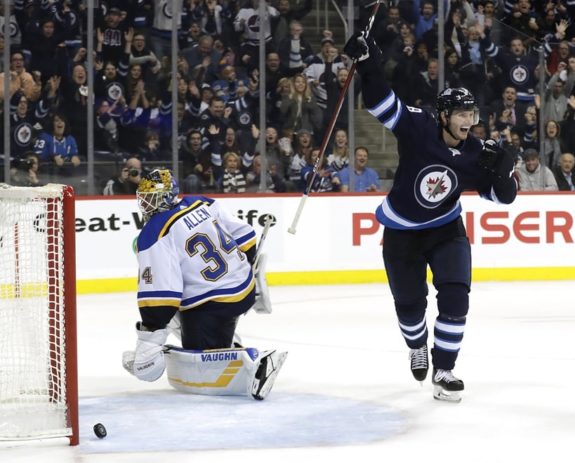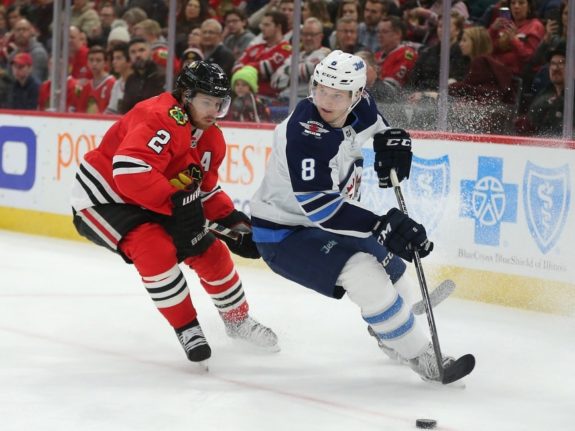You can bet Jacob Trouba’s eyes grew larger than dinner plates Thursday after seeing how much a fellow Central Division squad shelled out to extend a top-pairing defenseman long-term.
The man in question is the Dallas Stars’ Esa Lindell, who inked a lucrative six-year contract extension with an average annual value of $5.8 million.
If Lindell’s contract indicates the going rate of similar top-pairing d-men this offseason, the Winnipeg Jets’ restricted free agent d-man has good reason to salivate.
Lindell’s Good, But…
Lindell, who makes up the left side of the Stars’ top blue line pairing alongside John Klingberg, has blossomed similarly to Trouba into a high-quality defender and workhorse since being drafted 74th overall in 2012.
Although perhaps better known right now for his ridiculous dive during his team’s second-round matchup against the St. Louis Blues last month, Lindell “is a consummate professional who has proven himself in every situation” and possesses a combination of “strength, conditioning, hockey IQ and skill,” according to Stars’ general manager Jim Nill.

In 2018-19 — his third full NHL campaign — the 24-year-old set career-highs in points, (31) blocked shots (161) and hits (143) while skating an average of 24:20 per game. In 13 playoff games, he had four points and logged a whopping 26:58.
The Stars are obviously chuffed to have the Finn locked down through 2025, even if they had to give him a huge raise from the $2.2 million he made in each of his past two seasons.
…By Most Measures, Trouba’s Better
The reason Trouba’s likely drooling like a dog in an unaccompanied meat market is that Lindell’s near $6 million figure indicates a rise in stock of similar defensemen. It could motivate Trouba to demand more than the $7 million figure often thrown around when discussing a number he’d agree to.

Trouba is an elite, bona-fide shutdown d-man who tangles with opponents’ best every night. He’s more experienced than Lindell (he’s played in 408-career games opposed to Lindell’s 239), and has significantly more offensive upside (averaging .438 points per game over his career opposed to Lindell’s .322.)
Perhaps most importantly in the advanced-stat era, it’s possession-wise where Trouba most separates himself from Lindell. The Jets’ 2012 first-round pick’s career Corsi For Percentage at Even Strength of 50.6 and Fenwick For Percentage at Even Strength of 51.1 are better than Lindell’s 48.7 and 48.2.
In 2018-19, their numbers were even more drastically different: Lindell posted career-worsts in Corsi and Fenwick at 45 per cent and 44.5 per cent, respectively, while Trouba operated at 49.2 and 49.8 per cent.
Lindell’s been criticized for being carried by Klingberg. On the other hand, no one can (rationally) make the assertion Trouba’s held up by his partner, Josh Morrissey. Even when Nathan Beaulieu had to step into Morrissey’s slot through much of March, Trouba remained solid.
Lindell Deal Just Another Reason to Trade Trouba
You can add that Lindell’s contract may embolden Trouba to ask for even more than $7 million to the long list of compelling reasons why shipping out the 2012 ninth-overall pick is the right move, something we explored in detail earlier this month.
Related: The Case for Trading Jacob Trouba
The Jets cannot afford to pay Trouba John Carlson-esque money, given the oodles they’ll have to spend this summer to retain their boatload of UFAs and RFAs — Kyle Connor and Patrik Laine among them.

Whoever the Jets trade Trouba to will have to have deep pockets; the Detroit Red Wings and Florida Panthers are among the destinations that possess the cap space available to lock down someone who’s well-known for being a bulldog in contract negotiations.
While the chance of Trouba staying with the Jets was already small before the Lindell deal, it’s microscopic after given how it changes the dynamics of negotiations and gives Trouba the power. If for some reason you still expected Trouba back in a Jets jersey come fall, you definitely shouldn’t now.